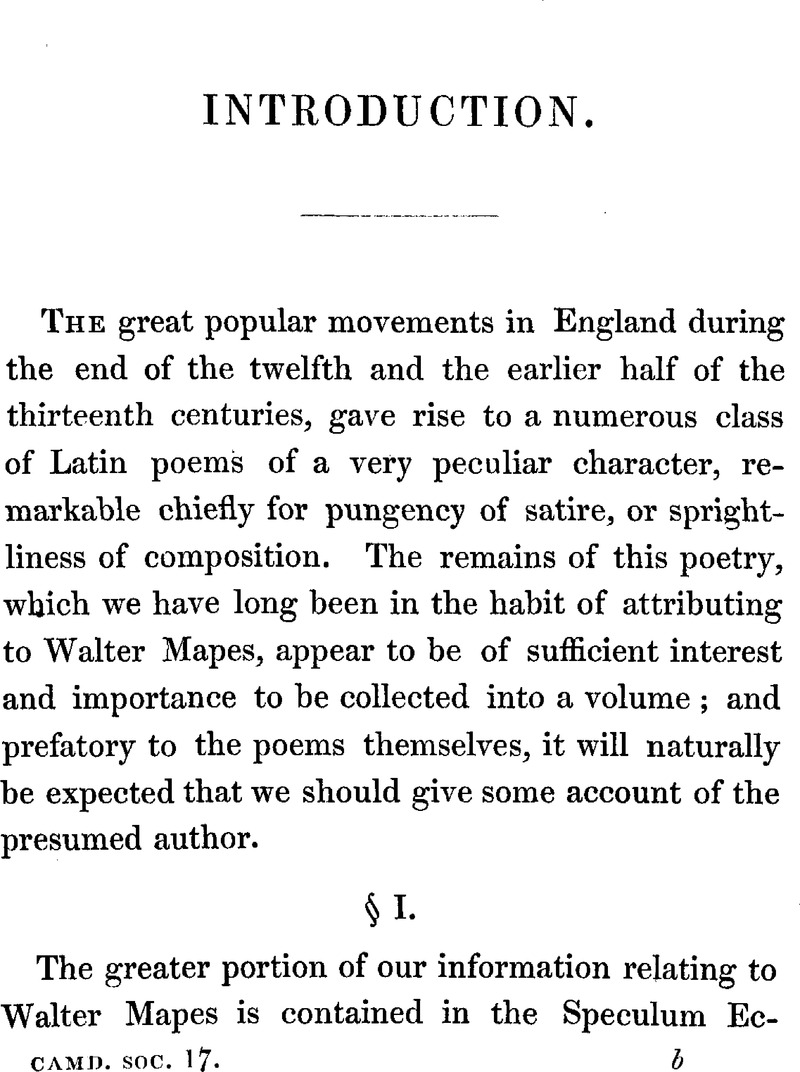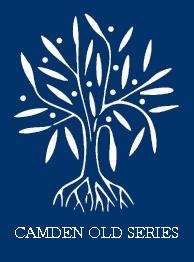No CrossRef data available.
Article contents
Introduction
Published online by Cambridge University Press: 23 February 2010
Abstract

Information
- Type
- Introduction
- Information
- Camden Old Series , Volume 16: The Latin Poems Commonly Attributed to Walter Mapes , July 1841 , pp. v - xxviii
- Copyright
- Copyright © Royal Historical Society 1841
References
page vi note * Gualterus Mape, de quo multa referuntur jocunda, ex prsecentore Lincolniensi Oxoniensis archidiaconus est effectus. Walsingham, Ypodigm. Neustr. p. 457.
page vi note † Tanner, in Mapaeus (Gualterius). Mapes informs us in his book, De Nugis Curialium, that he had studied at Paris.
page vii note * * See A P . I. at the end of our Preface.
page vii note † Iladulphus de Diceto, ecclesiae Sti. Pauli London, decanus, et ejusdem ecclesise capitulum, omnibus, etc. Noverit universitas vestra, quod nos donationem quara Gualterus Map Lincolniensis ecclesiae prsecentor et noster con-canonicus, etc. Tanner, as above.
page vii note ‡ Giraldus there speaks of Mapes in the following terms:— Unde et vir eloquio clarus W. Mapus archidiaconus (cujus animse propicietur Deus !) solita verborum facetia et urbanitate prascipua dicere pluries et nos in hunc modum convenire solebat, “Multa, magister Giralde, scripsistis, etmultumadhucscribitis, etnosmultadiximus ; vos scripta dedistis et nos verba.” Girald. Canib. Hibern. Exp. p. 813.
page viii note * * On this point, we need do no more than refer to Sir Frederick Madden's valuable Introduction to Syr Gawayne, and to M. Paulin Paris, Les Manuscrits Francois de la Bibliothèque du Roi, torn. ii. pp. 347, 362.
page viii note † The passages of Giraldus relating to Mapes are given from the MS. of his inedited work in the Appendix to our Introduction, AP. II. and AP. III.
page ix note * * See at the end of our Introduction, AP. IV.
page ix note † There is a MS. of this work at Oxford, in the Bodleian Library, and another in the Library of Merton college.
page ix note ‡ Manuscripts of this work are'not uncommon. There is more than one copy in the British Museum.
page ix note § See at the end of our Introduction, AP. V.
page x note * See Ducange, in voce.
page xi note * There appears to us to be a curious similarity between the sentiment expressed in the first of the two epigrams alluded to (the resemblance may perhaps be considered fanciful) and a fragment of the poet Archilochus, preserved in Athenaeus, Deipn. lib. i. p. 8.
Πολλλόν δ⋯νων και Φαλικρητoν μ⋯θν
ὧν ὐδ⋯ τιμ⋯ν εισ⋯κas, oὔτε μ⋯ν
κληθειs ⋯σ⋯λεs, oἶα δ⋯ χἶλos ⋯λλ⋯ σε
γαστ⋯ϱ ν⋯oν τε κα⋯ χϱεναs παϱ⋯γαγεν
⋯s ⋯ναιδἱην
page xii note * Recedentium autem [academicorum] quidam famuli, vel mancipia, vel illi quos solemus Goliardenses appellare, versus ridiculos componebant, dicentes,—
Heu ! morimur strati, vincti, mersi, spoliati;
Mentula legati nos facit ista pati.
Mat. Paris, p. 354, ed. Wats. In the glossary to this edition the word is explained by,—clerici, soil, ribaldi, qui Goliardi vulgo dicuntur: uti in concilium ad castrum Gonterii. Joculatores, mimi, quos buffones Itali vocant.
page xii note † See a note in the present volume, p. 251, 1. 13.
page xii note ‡ Item, prascipimus quod clerici non sint joculatores, goliardi, seu bufones. Ap. Martene, Thes. Anecd. torn. iv. col. 727. An old authority quoted by Ducange, v. goliardus, says, Goliardi, bufones, joculatores, iidem sunt.
page xii note § Clerici… si in goliardia vel histrionatu per annum fuerint. Martene, torn. iv. col. 729.
page xiii note * So in the Concil. Senon. ap. Concil. torn. ix. p. 578, Statuimus quod clerici ribaldi, maxime qui vulgo dicuntur de familia Golice. On the word ribaldi, see a note on the Political Songs, p. 369, where also will be found some further instances of the use of the word goliardus and goliardia; the expression clerici ribaldi describes exactly the class of persons of whom we have just been speaking. There is also a curious passage relating to the goliardi in the statutes of the Concil. Trevirense Anni 1227, ap. Martene et Durand. Ampliss. Collect, torn. vii. col. 117. Item, præcipimus ut omnes sacerdotes non permittant trutannos, et alios vagos scholares, aut goliardos, cantare versus super Sanctus et Angelus Dei in missis, &c.
page xiii note † See the title to A P . VII. of our Introduction.
page xiii note ‡ Pascat, potet, vestiat pueros Golyse. p. 70, of the present volume.
page xiii note § See the title to the poem on p. 54 of the present volume.
page xiii note | See AP. V. to the present Introduction.
page xiv note * Printed at the end of our Introduction, AP. VII.
page xiv note † II avient aucune foiz que jugleor, enchanteor, goliardois, et autres manieres de menesteriex, s'assemblent aus corz des princes et des barons et des riches homes, et sert chascuns de son mestier au mieuz et au plus apertement que il puet, pour avoir dons ou robes ou autres joiaus, et chantent et content noviaus motez et noviaus diz, et risies de diverses guises, et faignent à la loangence des riches homes quanque il puent faindre, pour ce que il leur plaisent mieuz. Grandes Chroniques de S. Denis, ap. Dom Bouquet, torn. xvii. p. 363.
page xiv note ‡ See A P . VI. to our Introduction.
page xv note * The Vision of Piers Ploughman, 1. 277, ed. Wright.
page xv note † Canterbury Tales, 1. 562, ed. Tyrwhitt.
page xvi note * See at the end of our Introduction, Ap. V.
page xvii note * See AP. IV. at the end of the Introduction.
page xvii note † See p. 54 of the present volume.
page xix note * See Appendix to the Introduction, Ap. V.
page xix note † See the note in the present volume, p. 71. It is very difficult to say when the Drinking Song was made, but it is perhaps not older than the sixteenth century. We know, however, that some of the same lines of the same poem had been introduced long before into a drinking song, a copy of which is preserved in a MS. of the fifteenth century in the British Museum, and is printed in the Appendix to our Introduction, Ap. VIII.
page xx note * See pp. 125, 126, 130.
page xxii note * The largest and earliest collection of these pieces which we know is contained in the Harleian manuscript, No. 978, and was made by a zealous partisan of Simon de Monfort, about the time of the battle of Lewes. Many of the poems contained in this MS. are unique. There is a modern transcript of many of them among the MSS. of Dr. James, No. 32, (in the Bodleian Library), from a note in which it appears that the Harleian MS., just referred to, was then in the possession of Dr. Lapworth, for there can be no doubt of the identity of the Harl. MS. with that from which Dr. James copied.
page xxiii note * A diligent search would probably bring others to light. Since the Appendix of Translations, &c. was printed off, we have observed that there is a French version of the Dialogue between the Body and the Soul, differing from those indicated in the note on p. 321, in one of the Arundel Manuscripts in the British Museum, MS. Arund. No. 288, fol. 247, v°. of the fourteenth century, commencing thus:—
Si come jeo jeu en mon lit,
Oy la voiz d'un espirit,
ky fust dampné,
Plaider fortment oue son corps,
Qe gist au cimetere dehors
enteré.
L'alme s'en est issue,
Ceo me ert vis tote nue
en guise d'un enfaunt;
Et ert la cheitive
Verte come cive,
et fesoit duel moult graunt.
It appears from a note in Warton (Hist. Engl. Poet. ii. 388, edition of 1840) that there exists an English translation of the French Débat du Cuer et de l'Oeil, (p. 310 of the present volume), printed perhaps before the year 1500, with the title, A Lytel Treatyse called the Dysputacyon or Complaynt of the Heart ihorughe perced with the lokynge of the Eye. Warton was not aware of the existence of a French original. The following is the first stanza of the English poem, as given by Warton:
In the fyrst weke of the season of Maye,
Whan that the wodes be covered in grene,
In which the nyghtyngale lyst for to playe
To shewe his voys among the thornes kene,
Them to rejoyce which Loves servaunts bene,
Which fro all comforte thynke them fast behynd,
My pleasyr was, as it was after sene,
For my dysport to chase the harte and hynde.
page xxiv note * One or two of these poems have been printed singly in more modern foreign publications, though little known in England, and from foreign manuscripts. Such is the case with the Dialogus inter Corpus et Animarn (p. 95), printed in v. Karajan's Frühlingsgabe, and the poem De Phillide et Flora (p. 258), printed in Aretin's Beitrage. The latter book I have not been able to meet with in England: it appears from my friend Mr. Ferdinand Wolf's learned work Ueber die Lais, Sequenzen, und Leiche (Heidelberg, 1841), p. 33, that in it is also printed a copy of the Dialogus inter Aquam et Vinum (p. 87) under the title De conflictu Vini et Aquæ.

